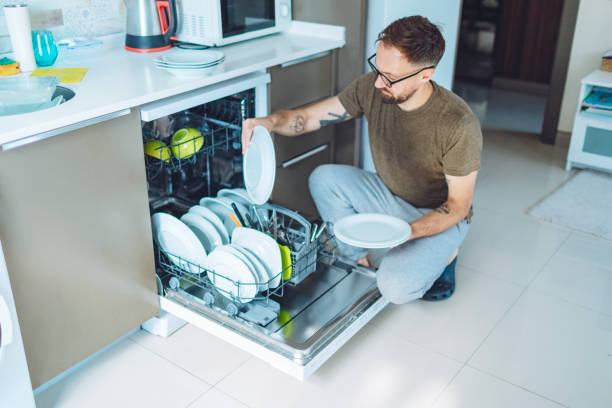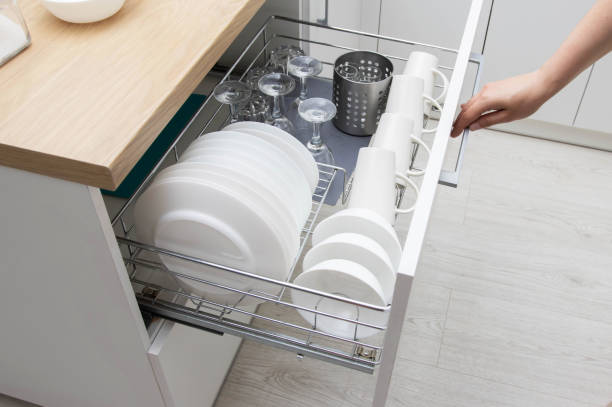Knowing how to properly load a dishwasher is key to ensuring your dishes come out clean and your machine runs efficiently. In this article, we will cover the best practices for loading your dishwasher, from arranging different types of dishware to the correct placement of detergents. Read on to find out how you can achieve sparkling results every time.
Understanding the Basics
To start with, it’s important to understand the fundamentals of how a dishwasher operates. Dishwashers have spray arms that need to spin freely to distribute water and detergent effectively. Blocking these spray arms with improperly placed items can severely impact cleaning performance. Ensuring proper spacing between items allows water and detergent to circulate properly, resulting in cleaner dishes.
The Bottom Rack: Heavier Items
The bottom rack is designed to hold heavier items such as pots, pans, and plates. When loading the bottom rack, place plates vertically, facing the center, with enough space between them for water to flow. Pots and pans should be placed at an angle, preferably facing downwards, to ensure water drains out. Be cautious not to stack these items too closely; proper spacing will allow for better cleaning. It’s also the best spot for dishwasher-safe cutting boards and large platters.
The Top Rack: Lighter and More Delicate Items
On the top rack, you should place lighter items like glasses, mugs, and small bowls. Cups and glasses should be placed upside down to allow water to drain properly and avoid pooling, which leads to water spots. Bowls should be angled to let water flow out. Keep in mind to avoid nesting items together, as this can prevent them from getting thoroughly cleaned. Any smaller, intricate pieces, such as plastic utensils, should be placed securely to avoid being dislodged by water pressure.
Utilizing Utensil Holder
The utensil holder is typically found on the lower rack. How you load utensils can make a significant difference. For spoon and fork handles, place them upwards to avoid nesting; however, knives should be placed handle-up to minimize injuries. Alternating the direction of utensils can also ensure better cleaning. Avoid overcrowding the utensil holder as it hinders water flow and leads to subpar cleaning results.

Detergent and Rinse Aid
Using the correct type and amount of detergent is crucial for effective cleaning. Typically, dishwasher detergent comes in powder, gel, or tablet form. Follow the manufacturer’s guidelines for the correct amount to use. Adding a rinse aid can also help prevent water spots and ensure a streak-free finish. Most dishwashers have a designated compartment for the rinse aid, which should be refilled regularly according to the instructions provided.
Steps to Load a Dishwasher Effectively
Loading a dishwasher can seem straightforward, but following these steps can ensure optimal performance:
- Scrape off large food particles before loading.
- Place heavier items like pots and plates on the bottom rack.
- Arrange lighter and delicate items like glasses on the top rack.
- Load utensils in the designated holder, taking care to alternate their direction.
- Add the appropriate amount of detergent and rinse aid.
- Ensure the spray arms can spin freely before starting the cycle.
Conclusion
Loading a dishwasher properly can significantly impact the cleanliness of your dishes and the longevity of your appliance. By understanding where and how to place different types of dishware, and by using the right amount of detergent and rinse aid, you can make sure that each dishwasher cycle is as effective as possible. Following these steps will lead to consistently cleaner dishes and a more efficient kitchen routine.
FAQs
1. Can I put wooden utensils in the dishwasher?
No, it’s advised not to put wooden utensils in the dishwasher as the high heat and moisture can cause the wood to warp or crack.
2. Should I pre-rinse dishes before loading them into the dishwasher?
Pre-rinsing is generally unnecessary. Scraping off large food particles is sufficient as most modern dishwashers are designed to handle minor food residue.
3. How often should I clean my dishwasher?
It’s good practice to clean the interior of your dishwasher once a month to remove any build-up and ensure optimal performance.
4. Can I wash non-stick cookware in the dishwasher?
It’s best to hand wash non-stick cookware. The dishwasher’s high heat and strong detergent can damage the non-stick coating over time.
5. Why are my dishes still wet after the dishwasher cycle ends?
This can be due to improper loading, insufficient rinse aid, or a malfunctioning heating element. Ensure your dishwasher is loaded correctly and that the rinse aid compartment is full before considering a technical issue.
